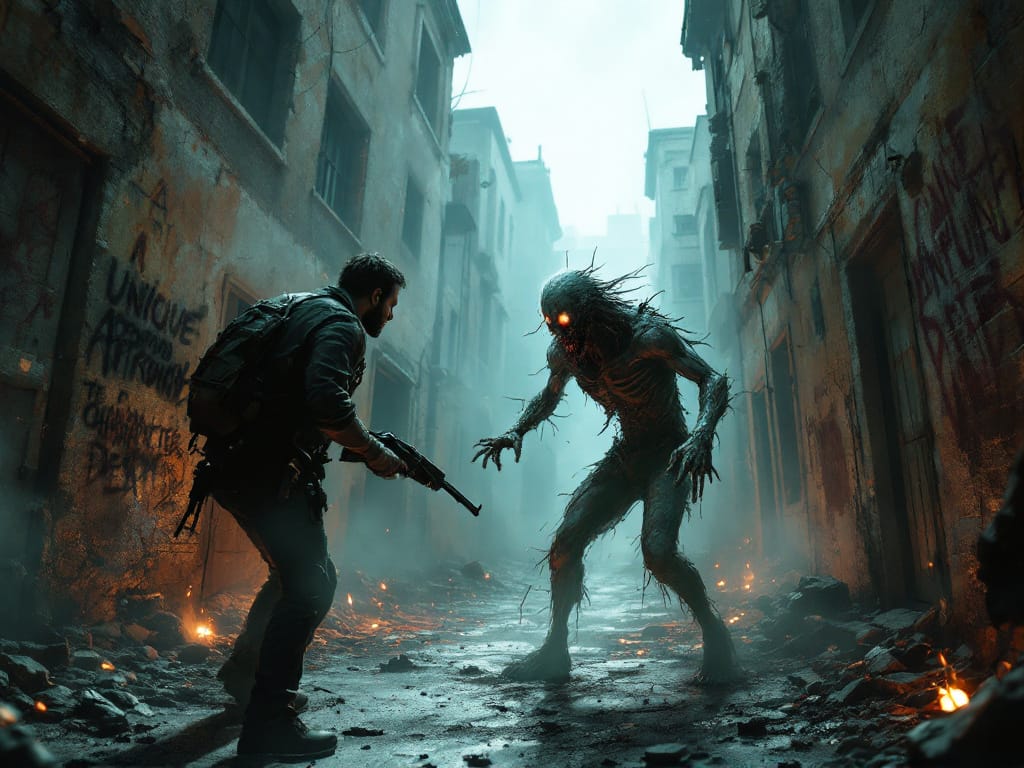The concept of atmosphere plays a pivotal role in video games, enriching players’ experiences by immersing them in virtual worlds. This article delves into the significance of atmosphere in video games, explores notable examples, and discusses the multitude of techniques employed to build and maintain atmosphere.
The Power of Game Atmosphere

The Role of Atmosphere in Creating Immersion
Atmosphere is a key element in establishing immersion within video games. It encompasses the setting, environment, ambience, and emotional tone felt by players. By carefully crafting these elements, game developers can evoke strong emotional responses, making players feel as though they are part of the game world.
The setting of a game contributes greatly to its atmosphere. Whether it is a post-apocalyptic wasteland, a mystical fantasy realm, or a bustling cityscape, the setting provides the backdrop for players to immerse themselves in. It sets the stage for the entire experience, shaping the player’s perception and expectations.
Additionally, the environmental details help create immersion by making the game world feel alive. The placement of trees, the weather effects, and the day-night cycle can all contribute to the atmosphere. They create a sense of realism and make players feel connected to the virtual environment.
The ambience of a game is another crucial factor in establishing immersion. The soundscape, including background music, environmental sounds, and character voices, can greatly impact the player’s emotional engagement. The ambient noises of birds chirping, wind blowing, or distant thunder can transport players into the game world and enhance their sense of presence.
Moreover, the emotional tone conveyed through visual and auditory cues is vital in evoking strong emotional responses. Whether it is through a haunting melody or a vibrant color palette, the emotional tone sets the mood and enhances the player’s connection to the game. It can make players feel joy, fear, excitement, or sadness, depending on the intended effect.
By carefully considering and integrating all these atmospheric elements, game developers can create a truly immersive experience. The role of atmosphere in video games is not merely limited to aesthetics, but it plays a key role in engaging the player’s senses, emotions, and imagination. It pulls players deeper into the game world, making them forget the real world and become fully immersed in the virtual environment.

Notable Games with Immersive Atmospheres
Several noteworthy games have successfully captured a captivating atmosphere. The eerie and haunting atmosphere of the Ishimura in “Dead Space,” the post-apocalyptic Chernobyl setting in “Stalker,” and the dark and mysterious world of “Majora’s Mask” are just a few examples. These games demonstrate how a compelling atmosphere can enhance the gameplay experience.
One game that particularly stands out for its immersive atmosphere is “Bioshock.” Set in the underwater city of Rapture, the game exudes a unique and unsettling atmosphere. As players explore the decaying surroundings and encounter mutated inhabitants, the haunting music, echoing voices, and dim lighting all work together to create a sense of unease and suspense. The underwater environment itself adds to the eerie atmosphere, with water seeping through cracks and broken glass casting distorted reflections.
Another game that excels in creating an immersive atmosphere is “The Witcher 3: Wild Hunt.” The vast and diverse open world of the game is beautifully crafted, with each region having its own distinct atmosphere. From the dense forests of Velen to the war-torn landscape of Novigrad, the game presents players with a living and breathing world. The dynamic weather system, realistic day-night cycle, and immersive sound effects contribute to a truly captivating experience. Additionally, the richly detailed characters and engaging narrative further enhance the game’s overall atmosphere.
In “Silent Hill 2,” the atmospheric horror is taken to another level. The foggy, desolate town of Silent Hill, with its dilapidated buildings and twisted creatures, creates a feeling of isolation and dread. The dimly lit, claustrophobic corridors of the town’s interiors intensify the sense of unease. The game’s haunting sound design, including the iconic radio static when enemy apparitions are near, adds to the overall immersive experience. The psychological horror elements present in the game further contribute to the building tension and oppressive atmosphere.
Overall, these games, along with many others, demonstrate the power of immersive atmospheres in enhancing the gameplay experience. Whether it be through eerie settings, realistic environments, or haunting sound design, a captivating atmosphere can draw players in and make their gaming experience truly unforgettable.

The Importance of Atmosphere in Overall Game Appeal
Atmosphere significantly contributes to a game’s overall appeal. It creates a unique identity and sense of place that draws players in, making them invested in the narrative and gameplay. Games with well-crafted atmospheres are more likely to leave a lasting impression on players.
- Strong Atmosphere = Memorable Gaming Experience: A compelling atmosphere makes a game stand out and creates a memorable experience for players. Even years later, players are likely to reminisce fondly about games with immersive atmospheres.
- Enhances Emotional Connection: Atmosphere enhances players’ emotional connection and involvement with the game. It pulls them into the game world, making them truly care about the story, characters, and environment.
- Replay Value: Well-crafted atmosphere adds replay value, as players want to re-experience the feelings and immersion induced by the game. This atmosphere cannot be replicated in other media forms.
- Competitive Advantage: A strong atmosphere gives a game competitive advantage in the marketplace. In an industry saturated with titles, atmosphere helps games stand apart.
- Complements Gameplay: An immersive atmosphere complements and enhances the actual gameplay. Game mechanics feel more engaging when complemented by a compelling atmosphere.
- World Building: Atmosphere is key in world building, making fictional game worlds feel real and lived-in. This allows players to suspend disbelief and immerse themselves fully.
In summary, atmosphere is not just an ancillary aspect but is fundamental to creating captivating games that resonate deeply with players. Investing in crafting immersive atmospheres pays dividends in the overall gaming experience.
Personal Value and Prioritization of Atmosphere
As a speaker, the value placed on atmosphere is subjective. Different players may prioritize varying aspects of a game, but personally, a captivating and immersive atmosphere is an integral part of the experience. It enhances the emotional impact and narrative engagement. For me, personal value and prioritization of atmosphere goes beyond just visually appealing graphics or realistic sound effects. It involves the overall ambiance created by the combination of music, sound design, visuals, and storytelling.
A captivating atmosphere can transport players into a different world or time, making them feel like they are a part of the game’s universe. It helps in creating a sense of immersion, where players can escape from reality and fully engage with the narrative and gameplay. It is the little details that contribute to this, such as the flickering of candle lights, the rustling of leaves in the wind, or the echoing footsteps in a desolate hallway.
Moreover, atmosphere significantly impacts the emotional impact of a game. It sets the tone and evokes specific feelings that are necessary for a memorable experience. Whether it’s the intense suspense in a horror game, the melancholic beauty in an adventure game, or the epic grandeur in a fantasy game, the atmosphere plays a vital role in enhancing these emotions.
In terms of prioritization, I believe that atmosphere should be carefully crafted to suit the overall vision of the game. It should seamlessly blend with the gameplay mechanics, the story, and the art style. Attention to detail is crucial to ensure that the atmosphere consistently reinforces the intended mood and theme.
Ultimately, a well-crafted and immersive atmosphere can grip players’ attention, allowing them to fully invest in the game’s world. It can even be influential in shaping players’ emotional responses and their overall enjoyment of the experience. Therefore, as a player, I highly value and prioritize a captivating and immersive atmosphere in the games I play.
The Difficulty of Defining Atmosphere
Defining atmosphere can be a challenging task due to its multifaceted nature. It goes beyond visual aesthetics, encompassing audio, narrative, and gameplay elements as well. Atmosphere is an amalgamation of various aspects working in harmony to create a specific feel for the game. These aspects include:
- Art style
- Sound design
- Level design
- Storytelling
- Character development
- Gameplay mechanics
All of these elements come together to immerse players in a unique and captivating experience.
One of the main difficulties in defining atmosphere lies in its subjective nature. Different players may perceive and interpret atmosphere in different ways. What may create a spooky and eerie atmosphere for one person, may evoke a sense of excitement and thrill for another. Thus, atmosphere is a highly personal and subjective aspect of gaming.
Furthermore, atmosphere is not restricted to a single genre or theme. It can be found in various types of games, ranging from horror and suspense to action-packed adventures or even serene and peaceful simulations. Each game genre aims to create a distinct atmosphere that aligns with its intended mood and gameplay.
Another challenge in defining atmosphere is its complexity. It is not solely dependent on one single element but rather a combination of several seamlessly integrated features. The visual aesthetics, for instance, play a crucial role in setting the tone and mood of the game. The color palette, lighting, and overall art direction all contribute to creating a specific atmosphere.
Audio also plays a significant role in shaping atmosphere. The use of ambient sounds, music, and sound effects can greatly enhance the desired feel of the game. Whether it’s the haunting melody in a horror game or the upbeat soundtrack in an action-packed game, the audio elements work hand in hand with other aspects to create a cohesive and engaging atmosphere.
Narrative and storytelling are yet another essential component of atmosphere. The game’s narrative, characters, and overall plot can evoke emotions and shape the atmosphere. A well-developed story can draw players into a game’s world, creating a sense of immersion and enhancing the overall atmosphere.
Lastly, gameplay mechanics also contribute to atmosphere. The way the player interacts with the game world, the challenges they face, and the overall pacing can all influence the atmosphere. For example, a game with slow and methodical gameplay may create a more suspenseful and tense atmosphere, while fast-paced action can evoke excitement and adrenaline.
In conclusion, defining atmosphere in gaming is a challenging endeavor due to its multifaceted and subjective nature. It encompasses various elements like visuals, audio, storytelling, and gameplay mechanics, all working together to create a specific feel or mood for the game. It is the culmination of these aspects that immerses players in a unique and captivating gaming experience

Building Atmosphere: Environmental Details, Notes, and Narration
Developers employ various techniques to build atmosphere. Environmental details, such as intricate level design, lighting, and weather effects, contribute to immersion. Notes, pictures, text, or audio logs provide additional insight into the game’s lore. Skillfully implemented narration can further deepen the atmosphere by guiding players through the story.
Environmental Details
Environmental details play a crucial role in building the atmosphere of a game. Developers pay great attention to crafting intricate level designs that transport players into immersive worlds. This includes carefully placing objects, creating realistic landscapes, and adding intricate textures to surfaces.
Another important aspect is lighting, which can greatly influence the mood and atmosphere of a game. Developers strategically use different lighting techniques, including shadows and dynamic lighting, to create a sense of depth and realism. This can range from dimly lit corridors in horror games to vibrant and sunny landscapes in open-world adventures.
Weather effects also contribute significantly to the overall atmosphere. Rain, thunderstorms, fog, and snowfall can enhance the immersion by creating a dynamic and ever-changing environment. These effects not only add visual appeal but also have the potential to affect gameplay, making players feel more connected to the virtual world.
Notes, Pictures, and Audio Logs
In addition to environmental details, developers utilize various narrative techniques to deepen the atmosphere. Notes, pictures, text, and audio logs scattered throughout the game provide valuable insights into the lore and backstory. These artifacts can contain hidden clues, unravel secret plots, or simply provide a glimpse into the game’s world, encouraging players to explore and discover more.
Skillful Narration
Narration is another powerful tool that developers employ to guide players through the story and enrich the atmosphere. Skillful implementation of voice acting and dialogue helps create a connection between players and the game’s characters. Hearing a character’s voice can evoke empathy, emotion, and immersion, making the narrative more engaging and captivating.
Overall, the combination of environmental details, notes, and narration work harmoniously to build a rich and immersive atmosphere in games. Developers focus on every aspect, from the smallest details to the grand scale, to ensure that players are transported into captivating worlds that keep them hooked from start to finish.

Cohesion in the Game’s World
Cohesion is vital for a well-crafted atmosphere. Every aspect, from art style to sound design, must align seamlessly with the game’s world. When all elements work harmoniously, players are fully immersed, allowing for a more engaging experience.
In order to achieve cohesion in the game’s world, it is important for the art style and sound design to complement each other. The art style sets the visual tone and aesthetic of the game, while the sound design enhances the atmosphere and provides auditory cues. When these two elements are in sync, they create a cohesive and immersive experience for the players.
Moreover, cohesion extends beyond just the visuals and sounds. The narrative, gameplay mechanics, and level design should also align with the game’s world. The narrative should be consistent and coherent, giving players a clear sense of purpose and context within the game. The gameplay mechanics should be intuitive and fit seamlessly into the world, allowing players to interact with the environment in a way that feels natural and cohesive.
Furthermore, level design plays a crucial role in maintaining cohesion. Each level should feel connected to the overall world and contribute to the game’s atmosphere. The layout, architecture, and environment should all be carefully crafted to create a sense of immersion and consistency. From the smallest details to the grandest vistas, every element should be carefully considered and designed to contribute to the overall cohesion of the game’s world.
Overall, achieving cohesion in the game’s world requires careful attention to detail and a holistic approach. When all aspects, from art style to sound design, narrative to gameplay mechanics, and level design to environmental details, align seamlessly, players are able to fully immerse themselves in the game. This leads to a more engaging and memorable experience that transports players to a cohesive and well-crafted world.
Greg Kasevin’s Definitions of Atmosphere in Video Games
Greg Kasevin, a renowned game designer, has provided insightful definitions of atmosphere in video games. His perspectives shed light on the impact of atmosphere on player engagement and the importance of synchronizing elements to create a cohesive experience.
According to Greg Kasevin, atmosphere in video games can be defined as the collective result of various elements that stimulate the player’s senses and emotions, ultimately immersing them in the game world. Kasevin emphasizes the importance of synchronizing these elements, such as visuals, sound design, storytelling, level design, and gameplay mechanics, to create a cohesive and captivating experience for the player.
The Role of Visuals
Visuals play a vital role in establishing the atmosphere of a game. The art style, graphics quality, lighting, and color palette all contribute to the overall mood and tone. Kasevin believes that attention to detail in visual presentation is crucial for creating a believable and engaging game world.
The Importance of Sound Design
Sound design is another key element in shaping the atmosphere of a video game. The use of ambient sounds, background music, and character voices can evoke specific emotions and enhance immersion. Kasevin asserts that well-designed sound effects can make the player feel more connected to the game world and heighten their emotional responses.
Storytelling for Immersion
Furthermore, storytelling is an essential aspect of atmospheric design. Kasevin suggests that a compelling narrative, delivered through dialogue, cutscenes, or environmental storytelling, can establish a sense of purpose and motivation for the player. Immersive and well-defined characters, along with a thoughtfully constructed plot, can foster a deeper connection between the player and the game world.
The Role of Level Design
Level design also plays a significant role in shaping atmosphere. Kasevin explains that the architecture, layout, and environmental details of game levels should align with the intended mood and theme. Intriguing level design can create a sense of exploration or tension, enhancing the overall atmospheric experience.
Gameplay Mechanics Matter
Lastly, gameplay mechanics should complement the atmosphere of a video game. Kasevin emphasizes that the gameplay should be designed to support and enhance the intended atmosphere. For example, fast-paced action sequences may heighten tension, while slower-paced puzzle-solving sections can contribute to a more mysterious and contemplative atmosphere.
In conclusion, Greg Kasevin’s definitions of atmosphere in video games emphasize the importance of synchronizing various elements to create a cohesive and engaging experience. Visuals, sound design, storytelling, level design, and gameplay mechanics all play crucial roles in immersing players in the game world. By carefully considering each of these elements, game designers can craft atmospheres that captivate players and elevate their overall engagement.
Examples of Games with Different Atmospheres
Different games evoke diverse atmospheres. The suspenseful and intense atmosphere of “Silent Hill,” the magical and whimsical realm of “Journey,” and the chilling horror of “Resident Evil” all demonstrate the versatility of atmosphere in gaming.
Animal Crossing
Another example of a game with a different atmosphere is “Animal Crossing.” This game creates a peaceful and relaxing atmosphere, where players can immerse themselves in a charming virtual world filled with adorable animal characters, delightful activities, and heartwarming interactions.
In contrast, the “Grand Theft Auto” series presents a gritty and chaotic atmosphere, depicting an open-world environment where players engage in criminal activities, high-speed chases, and intense shootouts. This game provides an adrenaline-fueled and action-packed experience, immersing players in a world of crime and danger.
“Portal” creates a uniquely puzzling and mysterious atmosphere. Players navigate through intricately designed test chambers while utilizing a portal gun to manipulate space and solve mind-bending puzzles. With its minimalist environment and eerie robotic voiceover, this game immerses players in a captivating and enigmatic atmosphere.
“Stardew Valley” offers a charming and nostalgic atmosphere reminiscent of classic farming simulation games. Players assume the role of a character who inherits their grandfather’s old plot of land and set out on a journey to restore the farm. With its cozy visuals, relaxing soundtrack, and wholesome interactions with the vibrant community, this game creates a warm and comforting atmosphere.
“Dark Souls,” on the other hand, presents a dark and foreboding atmosphere. Known for its punishing difficulty and unforgiving gameplay, this game immerses players in a bleak and unfriendly world. The haunting environments, haunting lore, and relentless enemies combine to create an atmosphere of despair and hopelessness.
“The Legend of Zelda: Breath of the Wild” evokes a sense of grandeur and adventure. Its vast open world dotted with ruins, forests, and deserts exudes a spirit of exploration. Interacting with friendly characters in villages contrasted with battling colossal enemies out in the wilderness creates an atmosphere that is both mystical and exciting.
These examples highlight the wide range of atmospheres that games can offer. From suspenseful and intense to whimsical and relaxing, gaming has the ability to transport players to different worlds and immerse them in unique and captivating experiences. It demonstrates the power and flexibility of atmospheric design in video games.
“Limbo” creates an eerie, haunting atmosphere with its black-and-white aesthetic, enigmatic environments, and dangerous traps. The dark visuals, coupled with the ambiguity surrounding the protagonist’s quest, evoke an unsettling yet compelling mood.
“Inside” builds on the atmospheric style of Limbo, using dim lighting and monochrome visuals to create an oppressive and claustrophobic feel. The game’s cryptic environments and themes of control and conformity contribute to an atmosphere that is simultaneously beautiful and disturbing.
“Firewatch” uses its Wyoming wilderness setting to cultivate a sense of isolation and introspection. The lush forests and rocky cliffs, paired with the intimacy of the protagonist’s radio conversations, make for a thoughtful atmosphere tinged with mystery.
“Return of the Obra Dinn” evokes the feel of an aging artifact with its 1-bit visuals and audio. The minimalist aesthetic, based on early Macintosh games, establishes an eerie atmosphere befitting the game’s supernatural mystery premise.
“Kentucky Route Zero” uses a magic realism aesthetic to create a somber, dreamlike atmosphere. The mundane is blended with the fantastic through the game’s visuals and avant-garde country/electronica soundtrack. The atmosphere reflects the characters’ struggles and the decaying spaces they inhabit.
“Sayonara Wild Hearts” generates euphoric momentum with its stylish visuals and catchy pop soundtrack. The game’s abstraction of concept albums into gameplay form makes for a dynamic audio-visual experience. This produces an energizing atmosphere that complements the fast-paced gameplay.
This further demonstrates how art direction, music, narrative, setting, and more can harmonize to produce a desired emotional atmosphere unique to each game. It is a testament to the power of video games as an artistic medium.
You can find more contents in our blog.






















